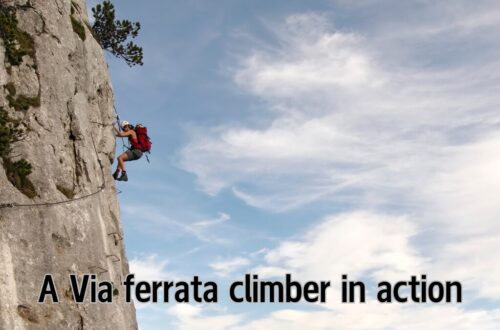Via Ferrata delle Bocchette: A fantastic route in the Brenta Dolomites
Right in the heart of the Brenta Dolomites in the Trentino-Alto Adige region of northern Italy, the Via Ferrata delle Bocchette is one of the most popular and scenic via ferrata routes in the Alps. This remarkable series of high-altitude traverses is famous for its jaw-dropping views, technical variety. It offers the chance to experience the alpine environment in a truly immersive way. Divided into several sections, the Bocchette route gives climbers the chance to spend multiple days high in the mountains, sleeping in rifugios and traversing dramatic ledges that cling to the vertical rock faces.

Overview of the Bocchette Route
The Via Ferrata delle Bocchette is not a single via ferrata, but a network of interconnected routes that stretch across the central Brenta group. It takes 3 to 5 days to complete depending on pace and chosen itinerary. Its most famous segment, the Bocchette Centrale, is widely considered the highlight due to its narrow ledges and astonishing exposure.
Key Facts:
- Region: Brenta Dolomites, Trentino-Alto Adige, Italy
- Duration: 3 to 5 days (can be split into shorter sections)
- Difficulty: Moderate to challenging
- Famous Segments: Bocchette Centrali, Bocchette Alte, Sentiero Benini, Sentiero Sosat
Click here for info about another amazing Via Ferrata adventure in Italy.
Highlights of the Bocchette Experience
1. Exhilarating Ledge Traverses
The hallmark of the Bocchette route is its stunning ledge systems that snake their way across towering rock faces. These ledges, often no more than a meter wide, offer vertigo-inducing views and the thrill of walking high above the valleys with hundreds of meters of air beneath your feet.
2. 360-Degree Mountain Vistas
Climbers get panoramic views of jagged limestone spires, deep alpine valleys, and snow-capped peaks. The Brenta Dolomites have a rugged, untamed beauty that feels different from the more polished Eastern Dolomites.
3. A Network of Historic Rifugios
One of the best things about this multi-day route is staying in the mountain huts, or rifugi. They offer hot meals, comfortable beds, and the camaraderie of fellow climbers. Notable rifugi along the route include Rifugio Tuckett, Rifugio Alimonta, and Rifugio Pedrotti.
4. A Taste of High-Altitude Alpinism
The Bocchette routes do not require technical climbing but they bring you into terrain typically reserved for alpine mountaineers: glaciated basins, rocky ridges, and dizzying heights. The use of iron cables and ladders allows non-climbers to safely explore these great settings.

Detailed Route Sections
Sentiero Benini
Often used as a starting point, this section begins near Passo Grosté and traverses rocky terrain with incredible views. It provides an ideal warm-up for what’s to come, combining short climbs and long traverses.
Bocchette Alte
This is the highest and most challenging section of the route. Starting from Rifugio Tuckett and ending near Rifugio Alimonta, it reaches over 3,000 meters in elevation. The route includes steep ladders, narrow ledges, and some sections that are less protected. It is physically and mentally demanding.
Bocchette Centrali
The most celebrated segment, this traverse is known for the Campanile Basso, a soaring spire that climbers pass up close. The ledges here are especially narrow and dramatic, offering some of the most unforgettable views in the Dolomites.
Sentiero delle Bocchette Inferiori & Sentiero Sosat
These easier segments are often used as exits or alternatives depending on conditions and stamina. The Sosat is a well-protected and scenic route that connects to lower elevation paths and returns to the valley.
Click here for a selection of outdoors-appropriate menswear.
Practical Information
Access Points and Logistics
The most common access point is from Madonna di Campiglio, a charming alpine town with lifts that take you into the Brenta group. Most climbers begin at Passo Grosté or Rifugio Vallesinella, using gondolas and buses to reach the trailheads. Early planning is important, as rifugios book up quickly during peak season.
Click here for an unforgettable European adventure.
Difficulty and Fitness Requirements
While none of the Bocchette sections are extreme in terms of technical climbing, the route demands:
- Good physical conditioning for long days at high altitude
- Sure-footedness and comfort with exposure
- Basic via ferrata experience
- Proper equipment and preparation
Click here for an incredible selection of European excursions.
What to Bring
Since this is a multi-day route, packing efficiently is crucial. Essentials include:
- Via Ferrata Kit: Harness, lanyards with shock absorbers, helmet
- Sturdy Boots: With good tread for mixed terrain
- Weather-Appropriate Clothing: Layers, waterproof jacket, gloves
- Sleeping Bag Liner: Required for rifugio stays
- Headlamp: In case of late finishes or early starts
- Snacks and Water: Though rifugios provide meals, it’s good to carry extras
- Cash: Many rifugios do not accept cards
- Map & Guidebook: For planning and safety
Safety and Considerations
- Weather: Afternoon thunderstorms are common. Start early and plan conservative days.
- Navigation: While trails are well-marked, poor visibility can make navigation tricky. A map or GPS app is essential.
- Acclimatization: Spend a night at a rifugio before beginning the main route to help acclimate to the altitude.
- Emergencies: Cell coverage is limited. Carry a whistle or a small emergency beacon if traveling solo.
Suggested Itinerary
Day 1: Arrive in Madonna di Campiglio, overnight in town.
Day 2: Take lift to Passo Grosté, traverse Sentiero Benini to Rifugio Tuckett.
Day 3: Climb Bocchette Alte, overnight at Rifugio Alimonta.
Day 4: Traverse Bocchette Centrali, descend via Sentiero Sosat to Rifugio Brentei or Rifugio Pedrotti.
Day 5: Hike back to valley or take connecting routes toward Molveno or return to Madonna di Campiglio.
Why Choose Via Ferrata delle Bocchette?
The Via Ferrata delle Bocchette offers one of the most spectacular and accessible ways to explore the high alpine world of the Brenta Dolomites. With its combination of awe-inspiring ledges, historic rifugios, and unforgettable mountain scenery, it is more than just a climb—it’s a full alpine journey. Ideal for climbers seeking a multi-day adventure with both physical and emotional rewards, this route delivers some of the best that the Dolomites have to offer.


